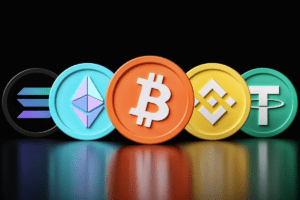Zrozumienie Solany
Aby w pełni zrozumieć potencjał Solany, ważne jest, aby najpierw zrozumieć, czym jest Solana i jej podstawy w technologii blockchain.
Czym jest Solana?
Solana to wysokowydajny blockchain platforma zaprojektowany w celu zapewnienia szybkich, bezpiecznych i skalowalnych rozwiązań dla zdecentralizowanych aplikacji (dApps) i kryptowalut. Jego celem jest zrewolucjonizowanie branży blockchain poprzez sprostanie kluczowym wyzwaniom, takim jak skalowalność, szybkość i koszty.
W swoim rdzeniu Solana wykorzystuje unikalne połączenie najnowocześniejszych technologii i innowacyjnych mechanizmów konsensusu, aby osiągnąć swoje cele. Wykorzystuje ona mechanizm konsensusu proof-of-history (PoH), który znakuje czasowo transakcje przed ich dodaniem do łańcucha bloków. Umożliwia to wysoką przepustowość transakcji i eliminuje potrzebę stosowania tradycyjnych mechanizmów konsensusu, które mogą spowalniać sieć.
Architektura Solana jest zbudowana tak, aby skalować się poziomo, co oznacza, że może obsługiwać zwiększone obciążenie sieci poprzez dodanie większej liczby walidatorów i zasobów sprzętowych. Ta skalowalność ma kluczowe znaczenie, ponieważ pozwala Solanie przetwarzać tysiące transakcji na sekundę, dzięki czemu dobrze nadaje się do aplikacji wymagających szybkich i tanich transakcji.
Aby dowiedzieć się więcej o technicznych aspektach Solany, można zapoznać się z poniższymi informacjami Biała księga Solana.
Podstawy technologii blockchain
Technologia blockchain stanowi podstawę Solany i wielu innych kryptowalut oraz zdecentralizowanych platform. Jest to zdecentralizowany i rozproszony system rejestrów, który bezpiecznie rejestruje i weryfikuje transakcje na wielu komputerach lub węzłach.
Podstawowe zasady technologii blockchain obejmują następujące kluczowe komponenty:
-
Decentralizacja: W przeciwieństwie do tradycyjnych scentralizowanych systemów, blockchain działa w zdecentralizowanej sieci. Oznacza to, że żaden pojedynczy podmiot nie ma kontroli nad całą siecią, co czyni ją bardziej odporną na cenzurę i pojedyncze punkty awarii.
-
Mechanizm konsensusu: Mechanizmy konsensusu to algorytmy wykorzystywane przez sieci blockchain do uzgadniania ważności transakcji i zapewnienia, że wszyscy uczestnicy utrzymują zsynchronizowaną kopię łańcucha bloków. Solana wykorzystuje mechanizm konsensusu proof-of-history (PoH), który zawiera weryfikowalny znacznik czasu dla każdej transakcji.
-
Niezmienna księga rachunkowa: Gdy transakcja zostanie zarejestrowana w łańcuchu bloków, staje się niezmienna i odporna na manipulacje. Zapewnia to wysoki poziom bezpieczeństwa i przejrzystości, ponieważ transakcje nie mogą być zmieniane ani usuwane bez zgody sieci.
-
Inteligentne kontrakty: Inteligentne kontrakty to samowykonujące się umowy z predefiniowanymi warunkami zakodowanymi w łańcuchu bloków. Umożliwiają one automatyzację złożonych transakcji i tworzenie zdecentralizowanych aplikacji (dApps) na platformach takich jak Solana.
Wykorzystując te fundamentalne zasady, Solana ma na celu przezwyciężenie ograniczeń tradycyjnych platform blockchain i dostarczenie wysokowydajnej infrastruktury dla przyszłości zdecentralizowanych aplikacji i kryptowalut.
Zagłębiając się w mapę drogową Solany, zbadamy jej wizję, kluczowe funkcje i kamienie milowe, które osiągnęła po drodze. Bądź na bieżąco, aby dowiedzieć się, jak Solana przekształca branżę blockchain.
Odkrywanie mapy drogowej Solana
Aby zrozumieć przyszły kierunek Solany, ważne jest, aby zbadać jej wizję, misję, a także kluczowe cechy i innowacje, które wyróżniają ją w przestrzeni blockchain.
Wizja i misja firmy Solana
Wizją Solana jest stworzenie wysokowydajnej platformy blockchain, która może wspierać powszechne wdrażanie zdecentralizowanych aplikacji (dApps) i zapewniać skalowalność dla globalnych systemów finansowych. Koncentrując się na szybkości, bezpieczeństwie i decentralizacji, Solana dąży do zrewolucjonizowania sposobu wykorzystania technologii blockchain.
Misją Solana jest zapewnienie programistom solidnej i przyjaznej dla użytkownika platformy do tworzenia skalowalnych aplikacji, umożliwiając im uwolnienie kreatywności bez ograniczania się ograniczeniami istniejących sieci blockchain. Oferując skalowalną infrastrukturę, Solana dąży do wypełnienia luki między tradycyjnym światem finansów a zdecentralizowaną przyszłością.
Kluczowe funkcje i innowacje
Solana wyróżnia się spośród innych platform blockchain ze względu na swoje unikalne funkcje i innowacje. Niektóre z kluczowych aspektów, które przyczyniają się do jej możliwości obejmują:
-
Skalowalność: Solana rozwiązuje jedno z głównych wyzwań stojących przed sieciami blockchain, zapewniając wysoką przepustowość i niskie opóźnienia. Jej unikalna architektura pozwala na równoległe przetwarzanie transakcji, umożliwiając sieci obsługę tysięcy transakcji na sekundę.
-
Dowód historii (PoH): Solana zawiera nowatorską koncepcję zwaną Proof of History, która zapewnia historyczny zapis wszystkich wydarzeń w łańcuchu bloków. Umożliwia to skuteczną weryfikację i synchronizację transakcji, zwiększając ogólne bezpieczeństwo i wydajność sieci.
-
Inteligentne kontrakty: Solana obsługuje wykonywanie inteligentnych kontraktów, umożliwiając programistom tworzenie złożonych zdecentralizowanych aplikacji na platformie. Wykorzystując wysoką przepustowość i niskie opóźnienia Solany, deweloperzy mogą tworzyć zaawansowane aplikacje, które mogą obsługiwać transakcje na dużą skalę.
-
Tokenomics: Solana ma swój natywny token, który odgrywa istotną rolę w zarządzaniu siecią, stakowaniu i mechanizmach motywacyjnych. Token Solana służy jako środek wymiany, motywując walidatorów i zabezpieczając sieć.
Aby uzyskać kompleksowe zrozumienie funkcji i innowacji Solana, można zapoznać się z poniższymi informacjami Biała księga Solana.
Postępując zgodnie ze swoim planem działania, Solana dąży do dalszego zwiększania swoich możliwości, rozszerzania ekosystemu i osiągnięcia powszechnego przyjęcia w branży blockchain. W następnej sekcji zajmiemy się konkretnymi etapami planu działania Solany.
Mapa drogowa Solany
Aby osiągnąć swoją wizję i misję, Solana opracowała kompleksowy plan działania składający się z kilku kluczowych etapów. Każda faza stanowi kamień milowy w rozwoju i ewolucji sieci Solana. Przyjrzyjmy się mapie drogowej Solana, podkreślając kluczowe fazy i ich cele.
Faza 1: Geneza
Faza Genesis oznacza początkowe uruchomienie i ustanowienie sieci Solana. Podczas tej fazy opracowano i wdrożono podstawowe elementy sieci Solana, takie jak mechanizm konsensusu i podstawowy protokół. Faza ta koncentrowała się na budowaniu silnych i bezpiecznych podstaw dla wydajnego działania sieci.
Faza 2: Budowanie fundamentów
W fazie budowania fundamentów Solana miała na celu zwiększenie możliwości sieci i rozszerzenie jej ekosystemu. Faza ta obejmowała rozwój różnych narzędzi i infrastruktury wspierającej deweloperów w tworzeniu zdecentralizowanych aplikacji (dApps) na platformie Solana. Ponadto podjęto wysiłki w celu wspierania tętniącej życiem i integracyjnej społeczności wokół Solany, zachęcając do współpracy i innowacji.
Faza 3: Skalowanie sieci
Skalowanie sieci jest kluczowym etapem dla Solany, ponieważ koncentruje się na rozwiązaniu jednego z największych wyzwań w technologii blockchain: skalowalności. Solana ma na celu zrewolucjonizowanie skalowalności blockchain poprzez wprowadzenie najnowocześniejszych technik i technologii. Dzięki funkcjom takim jak Proof of History (PoH) i architekturze Solana, sieć ma na celu osiągnięcie wysokiej przepustowości transakcji i niskich opóźnień, dzięki czemu nadaje się do szerokiego zakresu zastosowań. Aby dowiedzieć się więcej o skalowalności Solany, możesz zapoznać się z naszym artykułem na temat Skalowalność Solana.
Etap 4: Decentralizacja i zrównoważony rozwój
Ostatnia faza mapy drogowej Solany poświęcona jest osiągnięciu decentralizacji i długoterminowej stabilności. Solana dąży do decentralizacji sieci poprzez zwiększenie liczby walidatorów i zachęcanie społeczności do uczestnictwa. Faza ta koncentruje się również na zapewnieniu trwałości sieci poprzez wdrożenie mechanizmów zarządzania, bezpieczeństwa i stabilności gospodarczej. Aby dowiedzieć się więcej o zarządzaniu i stakingu Solany, możesz zapoznać się z naszymi artykułami na temat Solana tokenomics oraz Tyczenie Solana.
Podążając za tą mapą drogową, Solana dąży do stworzenia solidnej i skalowalnej platformy blockchain, która może obsługiwać szeroki zakres aplikacji i przypadków użycia. Mapa drogowa odzwierciedla zaangażowanie Solany w ciągłe innowacje i ulepszenia, torując drogę do obiecującej przyszłości. Aby być na bieżąco z najnowszymi osiągnięciami i kamieniami milowymi osiągniętymi przez Solana, śledź jej oficjalne kanały i aktualizacje społeczności.
Należy pamiętać, że mapa drogowa może ulec zmianie, ponieważ Solana dostosowuje się do nowych wyzwań i możliwości. Więcej szczegółowych informacji na temat mapy drogowej Solana i jej aspektów technicznych można znaleźć na stronie Biała księga Solana.
W następnej sekcji zbadamy znaczące osiągnięcia, które Solana już osiągnęła i omówimy przyszłe kamienie milowe i cele tej obiecującej platformy blockchain.
Kamienie milowe i osiągnięcia
Ponieważ Solana nadal wywołuje falę w branży kryptowalut i blockchain, osiągnęła kilka znaczących kamieni milowych na swojej mapie drogowej. Osiągnięcia te podkreślają postęp platformy i jej zaangażowanie w rewolucjonizowanie technologii blockchain.
Najważniejsze dotychczasowe osiągnięcia
Solana poczyniła znaczące postępy od momentu powstania, przyciągając uwagę i uznanie za swoje innowacyjne podejście. Niektóre z godnych uwagi osiągnięć obejmują:
-
Wysoka przepustowość: Solana zademonstrowała imponującą skalowalność, osiągając ponad 65 000 transakcji na sekundę (TPS) w swojej sieci testowej. Ta wysoka przepustowość pozycjonuje Solanę jako jedną z najszybszych istniejących sieci blockchain.
-
Szybki czas potwierdzenia: Architektura Solana o niskim opóźnieniu umożliwia szybkie czasy potwierdzeń, z czasami bloków wynoszącymi zaledwie 400 milisekund. Zapewnia to szybką finalizację transakcji, zwiększając komfort użytkowania i umożliwiając wydajne zdecentralizowane aplikacje (dApps).
-
Solidna infrastruktura: Infrastruktura Solany została zaprojektowana do obsługi ogromnej liczby węzłów i walidatorów, zapewniając bezpieczeństwo i stabilność sieci. Platforma przyciągnęła różnorodnych walidatorów, przyczyniając się do jej zdecentralizowanego charakteru.
-
Wzrost ekosystemu: Ekosystem Solana doświadczył niezwykłego wzrostu, z tętniącą życiem społecznością i licznymi partnerstwami. Współpraca ta obejmuje różne sektory i ma na celu wykorzystanie możliwości Solana do opracowywania innowacyjnych rozwiązań.
Przyszłe kamienie milowe i cele
Patrząc w przyszłość, Solana ma ambitną mapę drogową, która określa przyszłe kamienie milowe i cele. Platforma nadal stawia na skalowalność, decentralizację i zrównoważony rozwój. Niektóre kluczowe kamienie milowe i cele obejmują:
-
Faza 1: Genesis: Początkowa faza koncentruje się na budowaniu podstaw sieci Solana, ustanawiając kluczowe funkcje i infrastrukturę.
-
Faza 2: Budowanie fundamentów: W tej fazie Solana dąży do ulepszenia swojej podstawowej technologii i rozszerzenia ekosystemu poprzez partnerstwa i wsparcie dla deweloperów.
-
Faza 3: Skalowanie sieci: Solana jest zaangażowana w dalszą poprawę swojej skalowalności, dążąc do obsługi jeszcze większych wolumenów transakcji przy jednoczesnym zachowaniu krótkich czasów potwierdzenia.
-
Etap 4: Decentralizacja i zrównoważony rozwój: Ostatnia faza projektu Solana ma na celu osiągnięcie całkowitej decentralizacji, zapewniając długoterminową stabilność i odporność sieci.
Przyszłe kamienie milowe i cele Solany odzwierciedlają jej zaangażowanie w ciągłe innowacje i rozwój. Przesuwając granice technologii blockchain, Solana dąży do odblokowania nowych potencjalnych przypadków użycia i aplikacji. Aby dowiedzieć się więcej o technologii i ekonomii tokenów Solana, zapoznaj się z naszym artykułem na temat Solana tokenomics.
W miarę postępów Solana będzie nadal kształtować branżę kryptowalut i blockchain, zapewniając solidną i skalowalną platformę dla zdecentralizowanych aplikacji i innowacji finansowych.
Obiecująca przyszłość Solany
Ponieważ Solana nadal wywołuje fale w branży kryptowalut i blockchain, jej przyszłość wygląda niezwykle obiecująco. Dzięki innowacyjnej technologii i ambitnej mapie drogowej Solana jest gotowa zrewolucjonizować różne sektory. Przyjrzyjmy się potencjalnym zastosowaniom i przypadkom użycia Solany, a także jej wpływowi na branżę kryptowalut i blockchain.
Potencjalne zastosowania i przypadki użycia
Szybka, skalowalna i bezpieczna platforma blockchain firmy Solana otwiera szeroki wachlarz potencjalnych zastosowań i przypadków użycia. Oto kilka obszarów, w których oczekuje się, że technologia Solana będzie miała znaczący wpływ:
-
Zdecentralizowane finanse (DeFi): Szybkość przetwarzania transakcji Solana i niskie opłaty sprawiają, że jest to idealna platforma dla różnych aplikacji DeFi, takich jak zdecentralizowane giełdy, platformy pożyczkowe i pożyczkowe oraz stablecoiny. Jej skalowalność pozwala na płynną realizację złożonych transakcji finansowych.
-
Aplikacje zdecentralizowane (DApps): Solana zapewnia doskonałą platformę do tworzenia i wdrażania zdecentralizowanych aplikacji. Jej skalowalność i wysoka przepustowość umożliwiają DApps obsługę dużej liczby użytkowników i transakcji bez utraty wydajności.
-
Tokenizacja i zarządzanie aktywami: Blockchain Solana może ułatwić tokenizację rzeczywistych aktywów, takich jak nieruchomości lub dzieła sztuki, umożliwiając ułamkową własność i zwiększając płynność. Otwiera to możliwości efektywnego zarządzania aktywami i zwiększonej dostępności do tradycyjnie niepłynnych aktywów.
-
Zarządzanie łańcuchem dostaw: Przejrzysta i niezmienna księga Solana może być wykorzystywana do tworzenia bardziej wydajnych i bezpiecznych systemów zarządzania łańcuchem dostaw. Wykorzystując inteligentne kontrakty, firmy mogą śledzić i weryfikować każdy etap łańcucha dostaw, zapewniając autentyczność, przejrzystość i minimalizując oszustwa.
Wpływ na branżę kryptowalut i blockchain
Innowacyjna technologia Solana i ambitny plan działania mogą znacząco wpłynąć na branżę kryptowalut i blockchain na kilka sposobów:
-
Skalowalność: Solana koncentruje się na skalowalności, która jest jednym z głównych ograniczeń wielu sieci blockchain. Oferując wysoką przepustowość i niskie opóźnienia, Solana może obsługiwać ogromną liczbę transakcji, co czyni ją silnym konkurentem w wyścigu o skalowalne rozwiązania blockchain.
-
Ulepszone doświadczenie użytkownika: Dzięki krótkim czasom potwierdzania transakcji i niskim opłatom, Solana ma na celu zapewnienie płynnego doświadczenia użytkownika, dzięki czemu jest bardziej dostępna dla szerszego grona użytkowników. To ulepszone doświadczenie użytkownika może przyczynić się do większego przyjęcia technologii blockchain.
-
Konkurencja i innowacje: Innowacyjne podejście Solany do technologii blockchain zachęca do zdrowej konkurencji w branży. Jej unikalny algorytm konsensusu, Proof of History (PoH) i inne funkcje przesuwają granice tego, co jest możliwe, inspirując inne projekty do wprowadzania innowacji i ulepszania własnych technologii.
-
Rozwój ekosystemu: Rozwój i sukces Solany przyciąga deweloperów, przedsiębiorców i inwestorów, sprzyjając rozwojowi tętniącego życiem ekosystemu. Ekosystem ten obejmuje partnerstwa z różnymi projektami, współpracę z wiodącymi organizacjami oraz aktywną społeczność, która przyczynia się do ciągłego rozwoju i adopcji Solany.
Ponieważ Solana nadal realizuje swój plan działania i osiąga ważne kamienie milowe, oczekuje się, że umocni swoją pozycję kluczowego gracza w branży kryptowalut i blockchain. Jej potencjalne zastosowania, wpływ na skalowalność i wkład w innowacje sprawiają, że jest to ekscytujący projekt, który warto obserwować.
Aby zagłębić się w mapę drogową Solana i jej wpływ na branżę, koniecznie zapoznaj się z poniższymi informacjami Biała księga Solana i bądź na bieżąco z najnowszymi wydarzeniami w Ekosystem Solana.



